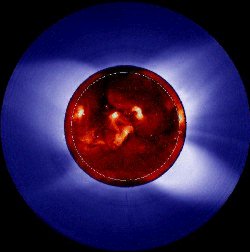This total solar eclipse in 1980 was photographed from Palem, India.
Click on image for full size
High Altitude Observatory and Rhodes College
High Altitude Observatory
Scientists at the
High Altitude Observatory (HAO) try to understand the changes we see in the
Sun over time. They also study how these changes affect the atmosphere of the
Earth. There are four main areas of study at HAO.
Some people try to understand the structure of the inside of the Sun, and how it changes over time. They collect detailed facts about the Sun, and try to learn about the basic processes that affect it.
Others focus on the magnetism of the Sun and the events we see near the surface. This connects the study of the conditions on the inside with the activity in the hot gas above the surface.
Another group of scientists build tools to observe the atmosphere
of the Sun, and try to understand the changes we see over hours or even years. Radiation and particles move out from the Sun, sometimes in sudden eruptions.
As the light and gas from the Sun reaches the Earth, others study the impact of the Sun's output on the magnetism and atmosphere of our planet. This helps us protect satellites and astronauts, and teaches us how the Sun affects our climate.
You might also be interested in:

To understand how our Sun works, it helps to imagine that the inside of the Sun is made up of different layers, one inside the other. The core, or the center of the Sun, is the region where the energy
...more
The Sun is not a quiet place, but one that exhibits sudden releases of energy. One of the most frequently observed events are solar flares: sudden, localized, transient increases in brightness that occur
...more
The visible solar atmosphere consists of three regions: the photosphere, the chromosphere, and the solar corona. Most of the visible (white) light comes from the photosphere, this is the part of the Sun
...more
IMF stands for Interplanetary Magnetic Field. It is another name for the Sun's magnetic field. The Sun's magnetic field is huge! It goes beyond any of the planets. The Sun's magnetic field got its name
...more
"Without warning, the relatively calm solar atmosphere can be torn asunder by sudden outbursts of a scale unknown on Earth. Catastrophic events of incredible energy...stretch up to halfway across the visible
...more
Scientists at the High Altitude Observatory (HAO) try to understand the changes we see in the Sun over time. They also study how these changes affect the atmosphere of the Earth. There are four main areas
...more
Energy from the Sun affects many things on Earth. One of the main things the Sun does is warm our planet, including the atmosphere. This energy drives much of our weather. The solar cycle, the rise and
...more
In the basic Hydrogen fusion cycle, four Hydrogen nuclei (protons) come together to make a Helium nucleus. This is the simple version of the story. There are actually electrons, neutrinos and photons involved
...more














